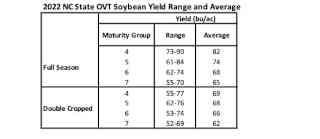By Mike Carroll
While climatic factors are often indeed the determining factor for yield within Eastern North Carolina, the weather and climate conditions are beyond an agricultural producer’s control. However, two significant factors of soybean yield that agricultural producers can control are the selection of variety and planting date. NC State research has repeatedly enforced that earlier planting is not only possible, but prudent. And, to be clear, these replicated studies have begun planting in mid-March. As such, each grower should evaluate planting practices to plan for early planting of soybean if high yield is desired. All full season soybeans should be targeted to be planted by early May. Data also show that planting earlier maturing varieties favor higher yield. Note the yield range and average for 2022 data below.

The second factor, selection of variety is a bit more complicated. Selection of a variety should include resistance to known disease or nematode populations, desired harvest date, and storage/transport considerations. High yield (80 bu/ac or higher) is possible with many varieties so these other factors, rather than simply yield, should be considered a priority. To select parameters that fit your operation (soil type, days above 95 degrees F, population, disease resistance, etc.) simply utilize the NC Variety Selection Tool. To begin discovery, first examine which soybean maturity group seems feasible. Data consistently shows that high yield is most likely with earlier maturing varieties when planted early. The chart below shows the percent of varieties tested in 2022 divided into two yield ranges: 1) 80+ bu/ac (blue); and, 2) between 70-80 bu/ac (orange) for full season planted soybeans. Note that almost 70% of Maturity Group IV soybeans yielded 80 bu/ac or greater compared to only about 15% of Maturity Group V. No soybeans within Maturity Groups VI or VII yielded this high. Note that a bit over 30% of the Maturity Group IV were between 70-80 bu/ac. Thus, 99% of Maturity Groups IV & V yielded at least 70 bu/ac.